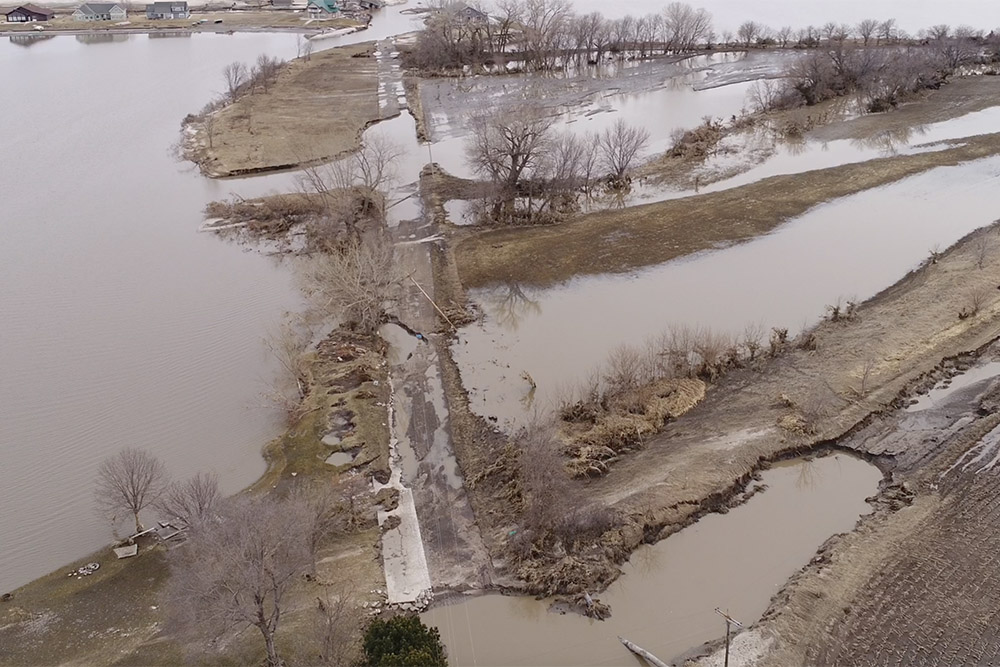Calendar Icon
Jul 30, 2020
Person Bust Icon
By Karl Vogel
![]() RSS
Submit a Story
RSS
Submit a Story

RELATED LINKS
The floods of March 2019 had a devastating impact on the State of Nebraska, with estimates of $1.5 billion in damages – nearly $1 billion to the agriculture industry and at least $450 million to infrastructure.
Numerous communities, including Fremont and Waterloo, were rendered virtual islands when rivers overwhelmed levees and washed away bridges and dams. Farm fields were so saturated and filled with debris, silt and sand that they were unusable for planting crops.
Recovery from the floods required quick responses and innovative approaches from government agencies, communities and individuals.
That's one of the reasons the College of Engineering and University Honors teamed up to offer a pop-up class titled "When the Levee Breaks" to study the myriad impacts and responses and to help find solutions for future disasters.
"As a college, we have a mission that includes both educating students to become engineers and to be a valuable partner to the State of Nebraska, its communities and its people," said Daniel Linzell, associate dean of graduate and international programs in the college. "The focus of this class and one of the most important things for us as a college was responding to the floods."
Linzell, also a professor of civil and environmental engineering, arranged the course and recruited two graduate students to help teach the class.
Over an October 2019 weekend, the course drew 10 students from three colleges – engineering, arts and sciences, and agricultural sciences and natural resources (CASNR) – and also included those with non-engineering majors such as English, agricultural science, environmental science and history.
"The goal was for students to develop innovative products that would help communities respond to floods and other disasters in the future or streamline processes to aid in community response," Linzell said.
To reach that goal, faculty and graduate student instructors delivered on-site lectures both in classrooms and at eight locations that were affected by the flooding, including the water treatment plant in Papillion, highway bridges, and a levee that was being renovated. Students even suggested possible locations for the class to visit, including farmland near Valley inundated with a large silt deposit.
Some of the instruction came from students enrolled in the course, many of whom were directly affected by the floods.
Linzell said the students developed ideas that demonstrated incredible innovation and the possibility of being a long-term resource for Nebraskans.
One idea is the development of a disaster response application for smart phones, which Linzell described as "sort of like a wedding registry for affected rural communities that don't have the items they need or necessary infrastructure to respond." One component of the app would match community needs with people and groups that have needed skills. Faculty in Computer Science and Engineering will be using the idea as a senior design capstone project in the 2020-21 academic year.
Inspired by that course, engineering faculty Phillip Barutha and Grace Panther decided to further investigate the flooding by developing their own pop-up: "Exploring Environmental Engineering," a 10-week summer class currently in session.
Four Nebraska faculty – Barutha, Panther and Tirthankar Roy from engineering, and Ursula Kreitmair from political science – are remote teaching the class that includes five students from engineering (two are graduate students) and a grad student from CASNR.
"It's a case study of the flooding, and we're taking an even deeper dive," Barutha said. "We have included a research component in which this small cohort interviews people from communities that were impacted, starting with some in northeast Nebraska. We want to capture about 20 stories and look specifically at infrastructure, how it's been impacted, and understand how communities are still being affected more than a year later.
Barutha said pop-up classes are a good vehicle for responding to current events and crises and for connecting academic and research opportunities to new methods and technologies that are embraced by students. Future pop-ups could tackle response to the current COVID-19 pandemic, he added.
"There some things we can learn from this that can improve infrastructure and the way we will be teaching our students in the future," Barutha said. "You don't get unprecedented natural disaster events like this very often, so it's important to learn from them.
"Pop-ups allow faculty and students to learn almost in real-time and do it in a way that engages a lot of different perspectives. They allow the flexibility to quickly pivot and are dynamic enough in delivery they can account for situations Nebraskans are dealing with today."
Linzell said the positive reactions to the classes and the realities of the COVID-19 pandemic mean more pop-up courses will likely be offered, including one on the pandemic he helped develop with business and journalism faculty that is currently being offered at the university.
"This pandemic has changed how we are teaching and telling us that we have to look at these changes as instructional opportunities," Linzell said. "We are learning more about our students – they want to be exposed to different things, be they problems or different types of learning environments and skills – and they want to address a problem now. That's what pop-ups offer."
Submit a Story
